University of London
| University of London | |
 King's College London, Embankment façade | |
|---|---|
| Founded: | 1836 |
| Chancellor: | The Princess Royal |
| Website: | london.ac.uk |
| Location | |
The University of London is a collegiate university located in and around London, in Middlesex, consisting of 18 constituent colleges, nine research institutes and a number of central bodies.[1] It is the second-largest university by number of full-time students in the United Kingdom, with 161,270 campus-based students and over 50,000 distance learning students in the University of London International Programmes.
The university was established by royal charter in 1836, as a degree-awarding examination board for students holding certificates from University College London (previously called London University) and King's College London and "other such other Institutions, corporate or unincorporated, as shall be established for the purpose of Education, whether within the Metropolis or elsewhere within our United Kingdom".[2] The university moved to a federal structure in 1900.[3]
For most practical purposes, ranging from admissions to funding, the constituent colleges operate on an independent basis, with some recently obtaining the power to award their own degrees whilst remaining in the federal university. The ten largest colleges of the university are University College London, King's College London, Queen Mary, City, Birkbeck, the London School of Economics and Political Science, Royal Holloway, Goldsmiths, the School of Oriental and African Studies (‘SOAS’), and St George's. The specialist colleges of the university include the London Business School, the Royal Veterinary College and Heythrop College, specialising in philosophy and theology. Imperial College London was formerly a member before leaving the university in 2007. City is the most recent constituent college, having joined on 1 September 2016.[4]
In post-nominals, the University of London is commonly abbreviated as Lond. or, more rarely, Londin., from the Latin Universitas Londiniensis, after its degree abbreviations.
History
19th century
University College London was founded under the name London University in 1826 as a secular alternative to the religious universities of Oxford and Cambridge.[5] In response to the theological controversy surrounding such educational establishment, King's College London was founded and was the first to be granted a royal charter (in 1829).[6][7]
Yet to receive a royal charter, University College London in 1834 renewed its application for a royal charter as a university (originally applied for in 1830), which would grant it the power to confer degrees.[8] In response to this, opposition to "exclusive" rights grew among the London medical schools. The idea of a general degree awarding body for the schools was discussed in the medical press.[9] and in evidence taken by the Select Committee on Medical Education.[10][11] However, the blocking of a bill to open up Oxford and Cambridge degrees to dissenters led to renewed pressure on the Government to grant degree awarding powers to an institution that would not apply religious tests,[12][13][14] particularly as the degrees of the new University of Durham were also to be closed to non-Anglicans.[15]
In 1835, the government announced the response to the college's petition for a charter. Two charters would be issued, one to University College incorporating it as a college rather than a university, without degree awarding powers, and a second "establishing a Metropolitan University, with power to grant academical degrees to those who should study at the London University College, or at any similar institution which his Majesty might please hereafter to name".[16]
Following the issuing of its charter on 28 November 1836, the university started drawing up regulations for degrees in March 1837. The death of King William IV in June, however, resulted in a problem – the charter had been granted "during our Royal will and pleasure", meaning it was arguably annulled by the king's death.[17] Queen Victoria issued a second charter on 5 December 1837, reincorporating the university. The university awarded its first degrees in 1839, all to students from University College and King’s College.
The university established by the charters of 1836 and 1837 was essentially an examining board with the right to award degrees in arts, laws and medicine. However, the university did not have the authority to grant degrees in theology, considered the senior faculty in the other three English universities. In medicine, the university was given the right to determine which medical schools provided sufficient medical training. In arts and law, by contrast, it would examine students from University College, King's College, or any other school or college granted a royal warrant, effectively giving the government control of which colleges could affiliate to the university. Beyond the right to submit students for examination, there was no other connection between the affiliated colleges and the university.
In 1849 the university held its first graduation ceremony at Somerset House following a petition to the senate from the graduates, who had previously received their degrees without any ceremony. About 250 students graduated at this ceremony. The London academic robes of this period were distinguished by their "rich velvet facings".[18]
The list of affiliated colleges grew by 1858 to include over 50 institutions, including all other British universities. In that year, a new charter effectively abolished the affiliated colleges system by opening up the examinations to everyone whether they attended an affiliated college or not.[19] This led the Earl of Kimberley, a member of the university's senate, to tell the House of Lords in 1888 "that there were no Colleges affiliated to the University of London, though there were some many years ago".[20] The reforms of 1858 also incorporated the graduates of the university into a convocation, similar to those of Oxford, Cambridge and Durham, and authorised the granting of degrees in science, the first BSc being awarded in 1860.[21]
The expanded role meant the university needed more space, particularly with the growing number of students at the provincial university colleges. Between 1867 and 1870 a new headquarters was built at 6 Burlington Gardens, providing the university with exam halls and offices.
In 1863, a fourth charter granted the university the right to grant degrees in surgery.[22] This 1863 charter remains the authority under which the university is incorporated, although all its other provisions were abolished under the 1898 University of London Act.
In 1878, the university set another first when it became the first university in the United Kingdom to admit women to degrees, by way of the grant of a supplemental charter. Four female students obtained Bachelor of Arts degrees in 1880 and two obtained Bachelor of Science degrees in 1881, again the first in the country.[23]
In the late 19th century, the university came under criticism for merely serving as a centre for the administration of tests, and there were calls for a "teaching university" for London. UCL and KCL considered separating from the university to form a separate university, variously known as the Albert University, Gresham University and Westminster University. Following two royal commissions, the University of London Act 1898 was passed, reforming the university and giving it a federal structure with responsibility for monitoring course content and academic standards within its institutions. This was implemented in 1900 with the approval of new statutes for the university.[24]
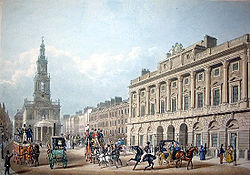
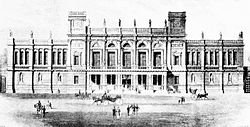 |
20th century
Reform came with new federal statutes in 1900. Many of the colleges in London became schools of the university, including University Colleg, King’s College Bedford College, Royal Holloway and the London School of Economics. Regent's Park College, which had affiliated in 1841, became an official divinity school of the university in 1901 (the new statutes having given London the right to award degrees in theology); Goldsmiths College joined in 1904; Imperial College was founded in 1907; Queen Mary College joined in 1915; the School of Oriental and African Studies was founded in 1916; and Birkbeck College, which was founded in 1823, joined in 1920.
The previous provision for colleges outside London was not abandoned on federation; instead, London offered two routes to degrees: "internal" degrees offered by schools of the university and "external" degrees offered at other colleges (now the University of London International Programmes).
University College and King's College, whose campaign for a teaching university in London had resulted in the university's reconstitution as a federal institution, went even further than becoming schools of the university and were actually merged into it. UCL's merger, under the 1905 University College London (Transfer) Act, happened in 1907. The charter of 1836 was surrendered and all of University College's property became the University of London's. King's College followed in 1910 under the 1908 King's College London (Transfer) Act. This was a slightly more complicated case, as the theological department of the college (founded in 1846) did not merge into the university but maintained a separate legal existence under King's College's 1829 charter.[25]
The expansion of the university's role meant that the Burlington Garden premises were insufficient, and in March 1900 it moved to the Imperial Institute in South Kensington.[26] However, its continued rapid expansion meant that it had outgrown its new premises by the 1920s, requiring yet another move. A large parcel of land in Bloomsbury near the British Museum was acquired from the Duke of Bedford and Charles Holden was appointed architect with the instruction to create a building "not to suggest a passing fashion inappropriate to buildings which will house an institution of so permanent a character as a University." This unusual remit may have been inspired by the fact that William Beveridge, having just become director of LSE, upon asking a taxi driver to take him to the University of London was met with the response "Oh, you mean the place near the Royal School of Needlework".[27] Holden responded by designing Senate House, the current headquarters of the university, and at the time of completion the second largest building in London.[28]
During the Second World War, the colleges of the university (with the exception of Birkbeck) and their students left London for safer parts of the UK, while Senate House was used by the Ministry of Information, with its roof becoming an observation point for the Royal Observer Corps. Though the building was hit by bombs several times, it emerged from the war largely unscathed; rumour at the time had it that the reason the building had fared so well was that Adolf Hitler had planned to use it as his headquarters in London.[29]
The latter half of the last century was less eventful. In 1948, Athlone Press was founded as the publishing house for the university, and sold to the Bemrose Corporation in 1979,[30] subsequent to which it was acquired by Continuum Publishing.[31] However, the post-WWII period was mostly characterised by expansion and consolidation within the university, such as the acquisition as a constituent body of the Jesuit theological institution Heythrop College on its move from Oxfordshire in 1969.
The 1978 University of London Act saw the university defined as a federation of self-governing colleges, starting the process of decentralisation that would lead to a marked transference of academic and financial power in this period from the central authorities in Senate House to the individual colleges. In the same period, UCL and KCL regained their legal independence via acts of parliament and the issuing of new royal charters. UCL was reincorporate in 1977, while KCL's new charter in 1980 reunited the main body of the college with the corporation formed in 1829. One of the largest shifts in power of this period came in 1993, when HEFCE switched from funding the University of London, which then allocated money to the colleges, to funding the colleges directly and them paying a contribution to the University.[24]
There was also a tendency in the late 20th century for smaller colleges to be amalgamated into larger "super-colleges". Some of the larger colleges (most notably University College, Kings College, the London School of Economics and Imperial College) periodically put forward the possibility of their departure from the university, although no steps were taken to actually putting this into action until the early 21st century.
21st century
In 2002, Imperial College and University College mooted the possibility of a merger, raising the question of the future of the University of London and the smaller colleges within it. Subsequently, considerable opposition from academic staff of both colleges led to a rejection of the merger.[32]
Despite this failure, the trend of decentralising power continued. A significant development in this process was the closing down of the Convocation of all the university's alumni in October 2003; this recognised that individual college alumni associations were now increasingly the centre of focus for alumni.[33] However, the university continued to grow even as it moved to a looser federation, and, in 2005, admitted the Central School of Speech and Drama.
On 9 December 2005, Imperial College became the second constituent body (after Regent's Park College) to make a formal decision to leave the university. Its council announced that it was beginning negotiations to withdraw from the university in time for its own centenary celebrations, and in order to be able to award its own degrees. On 5 October 2006, the University of London accepted Imperial's formal request to withdraw from it.[34] Imperial became fully independent on 9 July 2007, as part of the celebrations of the college's centenary.
The Times Higher Education Supplement announced in February 2007 that the London School of Economics, University College London and King's College London all planned to start awarding their own degrees, rather than degrees from the federal University of London as they had done previously, from the start of the academic year starting in Autumn 2007. Although this plan to award their own degrees did not amount to a decision to leave the University of London, the THES suggested that this "rais[ed] new doubts about the future of the federal University of London".
The School of Pharmacy, University of London, merged with UCL on 1 January 2012, becoming the UCL School of Pharmacy within the Faculty of Life Sciences.[35] This was followed on 2 December 2014 by the Institute of Education also merging with University College London, becoming the UCL Institute of Education.[36]
Following good results in the Research Excellence Framework in December 2014, City University London said that they were exploring the possibility of joining the University of London.[37] It was subsequently announced in July 2015 that City would join the University of London in August 2016.[4] It will cease to be an independent university and become a college as "City, University of London".[38]
Campuses

The university owns a considerable central London estate of 30 acres freehold land in Bloomsbury, near Russell Square tube station.[39]
Some of the university's colleges have their main buildings on the estate. The Bloomsbury Campus also contains eight Halls of Residence and Senate House, which houses Senate House Library, the chancellor's official residence and previously housed the School of Slavonic and East European Studies, now part of University College London (UCL) and housed in its own new building. Almost all of the School of Advanced Study is housed in Senate House and neighbouring Stewart House.[40]
The university also owns many of the squares that formed part of the Bedford Estate, including Gordon Square, Tavistock Square, Torrington Square and Woburn Square, as well as several properties outside Bloomsbury, with many of the university's colleges and institutes occupying their own estates across London:
- Clare Market,
- Part of Aldwych, where the London School of Economics and Political Science is based
- The West and East Wings of Somerset House, the location for the Courtauld Institute of Art and King's College London, respectively
- St Bartholomew's Hospital,
- the University of London Boat Club in Chiswick, and
- the Egham campus of Royal Holloway with its historic Founder's Building.
The university also has several properties outside London, including a number of residential and catering units further afield and the premises of the University of London Institute in Paris, which offers undergraduate and postgraduate degrees in French and historical studies.
Organisation and administration
The ten largest institutions of the federal university, usually termed the colleges, are Birkbeck, Goldsmiths, King's College, the London Business School, Queen Mary, Royal Holloway, the School of Oriental and African Studies, City, the London School of Economics and University College London. Formerly a constituent college, Imperial College London left the University of London in 2007.
For most practical purposes, ranging from admission of students to negotiating funding from the government, the 18 constituent colleges are treated as individual universities. Legally speaking they are known as Recognised Bodies, with the authority to examine students and award them degrees of the university. Some colleges have the power to award their own degrees instead of those of the university; those which exercise that power include:
- Royal Holloway, University of London
- The School of Oriental and African Studies
- City, University of London
- Goldsmiths
- St George's
- Queen Mary
- King's College London
- University College London
- The London School of Economics and Political Science
Most decisions affecting the constituent colleges and institutions of the University of London are made at the level of the colleges or institutions themselves. The University of London does retain its own decision-making structure, however, with the Collegiate Council and Board of Trustees, responsible for matters of academic policy. The Collegiate Council is made up of the Heads of Colleges of the university.[41]
The 12 institutes, or Listed Bodies, within the University of London offer courses leading to degrees that are both examined and awarded by the University of London. Additionally, twelve universities in England, several in Canada and many in other Commonwealth countries (notably in East Africa) began life as associate colleges of the university offering such degrees. By the 1970s, almost all of these colleges had achieved independence from the University of London. An increasing number of overseas and UK-based academic institutes offer courses to support students registered for the University of London International Programmes's diplomas and degrees and the Teaching Institutions Recognition Framework enables the recognition of these institutions.
Colleges
The current constituent colleges of the University of London are as follows:
| College Name | Year Entered | Photograph |
|---|---|---|
| Birkbeck College | 1920 |  |
| City, University of London | 2016 | 
|
| Courtauld Institute of Art | 1932 |  |
| Goldsmiths' College | 1904 |  |
| Heythrop College | 1971 |  |
| Institute of Cancer Research | 2003 |  |
| King's College London | 1836 (Founding College) |  |
| London Business School | 1964 |  |
| London School of Economics and Political Science ('the LSE') | 1900 | 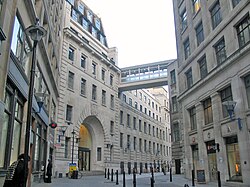 |
| London School of Hygiene and Tropical Medicine | 1924 |  |
| Queen Mary University of London | 1915 |  |
| Royal Academy of Music | 2003 |  |
| Royal Central School of Speech and Drama | 2005 |  |
| Royal Holloway and Bedford New College | 1900 |  |
| Royal Veterinary College | 1915 | 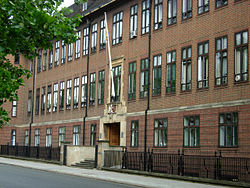 |
| School of African and Oriental Studies | 1916 |  |
| St George's Hospital Medical School | 1836 (Joined after founding) |  |
| University College London (UCL) | 1836 (Founding College) | 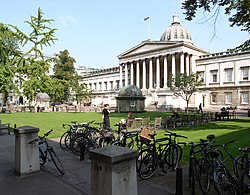 |
| University of London | Founded University |  |
Central academic bodies
- University of London Institute in Paris, formerly known as the British Institute in Paris
- School of Advanced Study comprising the following institutes:
- the Institute of Advanced Legal Studies
- the Institute of Classical Studies
- the Institute of Commonwealth Studies
- the Institute of English Studies
- the Institute of Historical Research
- the Institute of Latin American Studies
- the Institute of Modern Languages Research
- the Institute of Philosophy
- the Warburg Institute
- University of London International Programmes
Colleges in special relation
Between 1946 and 1970, the university entered into 'schemes of special relation' with university colleges in the Commonwealth of Nations. These schemes encouraged the development of independent universities by offering a relationship with the University of London. University colleges in these countries were granted a Royal Charter. An Academic Board of the university college negotiated with the University of London over the entrance requirements for the admission of students, syllabuses, examination procedures and other academic matters. During the period of the special relationship, graduates of the colleges were awarded University of London degrees.
Some of the colleges which were in special relation are listed below, along with the year in which their special relation was established.
- 1946 – The University College of the West Indies, until 1961. (Now the University of the West Indies)[42]
- 1948 – University College, Ibadan, until 1967. (Now the University of Ibadan)
- 1956 – University College of Rhodesia and Nyasaland (now the University of Zimbabwe).
- 1961 – Royal College Nairobi (now the University of Nairobi).
- 1963 – University of East Africa
In 1970, the 'Schemes of Special Relation' were phased out.
Coat of arms
The University of London first received a grant of arms in April 1838.[43] The arms depict a cross of St George upon which there is a Tudor rose surrounded by detailing and surmounted by a crown. Above all of this there is a blue field with an open book upon it.
The arms are described in the grant as:
- Argent, the Cross of St George, thereon the Union Rose irradiated and ensigned with the Imperial Crown proper, a Chief Azure, thereon an open Book also proper, Clasps gold[43]
Academic dress
The University of London had established a rudimentary code for academic dress by 1844. The university was the first to devise a system of academic dress based on faculty colours, an innovation that was subsequently followed by most other universities.
Since their being granted autonomous degree awarding powers, King's College, The London School of Economics and Political Science and University College London have each introduced their own form of academic dress. Queen Mary, University of London will, as of 2014, introduce its own form of academic dress to reflect its autonomous degree awarding powers.[44] The remaining colleges of the university continue to use the University of London academic dress.
Student life

Approximately 5% of all UK students attend one of the University of London's colleges and affiliated schools. Additionally, over 50,000 students follow the University of London International Programmes.
The University of London Union building on Malet Street (close to Senate House) was home to the University of London Union, which acted as the student union for all University of London students alongside the individual college and institution unions. The building is now rebranded as 'Student Central, London', offering full membership to current University of London students, and associate membership to students at other universities, and other groups. The union previously owned London Student, the largest student newspaper in Europe, which now runs as a digital news organisation[45][46]
Sports, clubs and traditions
Though most sports teams are organised at the college level, the Union ran a number of sports clubs of its own, some of which (for example the basketball team) compete in British Universities and Colleges Sport leagues. The union also organised its own leagues for college teams to participate in. These leagues and sports clubs are supported by Friends of University of London Sport which aims to promote them.
In addition to these, the University of London Union catered for sports not covered by the individual colleges through clubs such as the University of London Union Lifesaving Club, which helps students gain awards and learn new skills in lifesaving as well as sending teams to compete throughout the country in the BULSCA league.
The university's ice hockey squad, the ULU Dragons, have been successful in the British Universities Ice Hockey Association Division 1 and Division 2. The Dragons have also previously competed in tournaments including professional teams and have come away with several gold and silver medals from these events.
ULU also organised a number of societies, ranging from Ballroom and Latin American Dance to Shaolin Kung Fu, and from the University of London Big Band to the Breakdancing Society. Affiliated to the university is the University of London Society of Change Ringers, a society for bellringers at all London universities.
The university runs the University of London Boat Club.
The university also has a representative football team, which dates back to 1913 and is a collection of the best players from the various colleges. The team plays games against sides such as Cambridge's and Oxford's 'Blues' sides as well as the R.A.F, Navy and Army. Currently the team has use of both Motspur Park Athletics Stadium (Fulham F.C.'s training ground, and a former University of London property) and the Honourable Artillery Company's grounds for training and home match purposes. Former players and managers of the team include Bobby Robson and Jimmy Hill.
The University of London Orienteering Club is an umbrella club for all University of London orienteering groups. Members participate in orienteering events across the United Kingdom, and occasionally further afield. In 1997, the club sent a team to participate in the US championships in Colorado.
The University of London Symphony Orchestra is a leading British student orchestra, with some 0 to 100 students from the University annually, and it welcomes world-renowned conductors and soloists. The orchestra dates back to 1955 is well known for performing some of the most challenging works in the repertoire. The orchestra has played in some of London's foremost concert halls including Cadogan Hall, St John's Smith Square, Duke's Hall and has been on tour in Hong Kong and Italy in recent years.
Outside links
| ("Wikimedia Commons" has material about University of London) |
- University of London
- University of London Archives
- University of London student lists
- The University of London Act 1994
- University of London military service,1914–1945
References
- ↑ "About us". University of London. 22 June 2016. http://www.london.ac.uk/aboutus.html. Retrieved 22 June 2016.
- ↑ https://books.google.com/books?id=vyPiAAAAMAAJ&pg=PA26&source=gbs_toc_r&cad=4#v=onepage&q&f=false
- ↑ https://books.google.com.pr/books?id=vyPiAAAAMAAJ&pg=PA7&source=gbs_toc_r&cad=4#v=onepage&q&f=false
- ↑ Jump up to: 4.0 4.1 Grove, Jack (16 July 2015). "City University London to join University of London". https://www.timeshighereducation.co.uk/city-university-london-join-university-london. Retrieved 16 July 2015.
- ↑ "History". University College London. http://www.ucl.ac.uk/about-ucl/about-ucl-home/history-page. Retrieved 22 April 2011.
- ↑ Cockburn, King, McDonnell (1969), pp. 345–359
- ↑ "Foundation". King's College London. http://www.kcl.ac.uk/aboutkings/history/foundation.aspx. Retrieved 9 February 2013.
- ↑ University of London. Address from the Senate to the Council in support of the application of the University for a charter. 1834. https://books.google.com/books?id=kS1cAAAAcAAJ&pg=PA1&f=false#v=onepage&q&f=false.
- ↑ "Proposed University in London". London Medical Gazette 13: 836–839. 1834. https://books.google.com.pr/books?id=XLofAAAAMAAJ&pg=PA836&lpg=PA836&f=false#v=onepage&q&f=false.
- ↑ "Select Committee on Medical Education". Parliamentary Papers, House of Commons and Command, Part 2. HMSO. 1834. p. 113. https://books.google.com.pr/books?id=w0sSAAAAYAAJ&pg=PA113&f=false#v=onepage&q&f=false.
- ↑ "Select Committee on Medical Education". Selection of Reports and Papers of the House of Commons: Medical ; [2], Volume 36. 1836. pp. 111. https://books.google.com.pr/books?id=3CFDAAAAcAAJ&pg=PA111&f=false#v=onepage&q&f=false.
- ↑ http://hansard.millbanksystems.com/lords/1834/aug/01/admission-to-the-universities#S3V0025P0_18340801_HOL_5
- ↑ http://hansard.millbanksystems.com/commons/1835/mar/26/london-university#S3V0027P0_18350326_HOC_68
- ↑ http://www.jstor.org/stable/3119682?seq=1#page_scan_tab_contents
- ↑ http://hansard.millbanksystems.com/commons/1832/jun/27/durham-university#S3V0013P0_18320627_HOC_9
- ↑ http://hansard.millbanksystems.com/commons/1835/jul/30/london-university#S3V0029P0_18350730_HOC_24
- ↑ https://books.google.com.pr/books?id=TZtRAAAAcAAJ&pg=PA565&lpg=PA565&f=false#v=onepage&q&f=false
- ↑ "University of London". Morning Chronicle. 11 May 1849. http://www.britishnewspaperarchive.co.uk/viewer/bl/0000082/18490511/017/0007. Retrieved 14 December 2015.
- ↑ https://books.google.com.pr/books?id=vyPiAAAAMAAJ&pg=PA39&source=gbs_toc_r&cad=4#v=onepage&q&f=false
- ↑ http://hansard.millbanksystems.com/lords/1888/aug/11/consideration-of-commons-amendments#S3V0330P0_18880811_HOL_23
- ↑ Francis Michael Glenn Willson (2004). The University of London, 1858–1900: The Politics of Senate and Convocation. Boydell Press. p. 5. https://books.google.com.pr/books?id=NOd3N6291CQC&pg=PA5&lpg=PA5&f=false#v=onepage&q&f=false.
- ↑ https://books.google.com/books?id=vyPiAAAAMAAJ&pg=PA12&source=gbs_toc_r&cad=4#v=onepage&q&f=false
- ↑ "University of London: Brief history". London.ac.uk. http://www.london.ac.uk/history.html. Retrieved 2010-04-13.
- ↑ Jump up to: 24.0 24.1 Malcolm Grant (March 2005), The future of the University of London: a discussion paper from the Provost of UCL, pp. 3–6, http://www.ucl.ac.uk/images/Uni-Lon.pdf
- ↑ University of London, the Historical Record: (1836–1912). University of London. 1912. pp. 7–24. https://books.google.com.pr/books?id=vyPiAAAAMAAJ&pg=PA7&focus=viewport&output=html.
- ↑ https://books.google.com/books?id=NOd3N6291CQC&pg=PA8&lpg=PA8&f=false#v=onepage&q&f=false
- ↑ "City of Sound". City of Sound. 22 November 2003. http://www.cityofsound.com/blog/2003/11/senate_house_un.html. Retrieved 2010-04-13.
- ↑ Emporis GmbH. "Emporis Buildings". Emporis.com. http://www.emporis.com/en/wm/bu/?id=110747. Retrieved 2010-04-13.
- ↑ "Senate House, Bloomsbury, WC1 — The Twentieth Century Society". c20society.org.uk. http://www.c20society.org.uk/botm/senate-house-bloomsbury-wc1.
- ↑ Archives in London & the M25 area (AIM25) (29 November 2006), "Athlone Press: 1945–1979", holdings at Senate House Library, University of London, http://www.aim25.ac.uk/cats/14/1671.htm, retrieved 21 December 2009
- ↑ allbusiness (29 November 2006), "Sturrock departs Continuum", Article citing companies encompassed by Continuum, http://www.allbusiness.com/retail-trade/miscellaneous-retail-miscellaneous/4663699-1.html, retrieved 21 December 2009
- ↑ The Guardian. 18 November 2002 Opposition ends Imperial and UCL merger dream
- ↑ http://www.london.ac.uk/52.html
- ↑ CBLAIR. "News_5-10-2006-13-17-17". imperial.ac.uk. http://www3.imperial.ac.uk/newsandeventspggrp/imperialcollege/newssummary/news_5-10-2006-13-17-17?newsid=2736.
- ↑ School of Pharmacy merges with UCL. Ucl.ac.uk (1 January 2012). Retrieved on 2013-07-17.
- ↑ https://www.ucl.ac.uk/news/news-articles/1114/251114-ucl-ioe-confirm-merger
- ↑ http://www.theguardian.com/education/2015/jan/20/universities-research-excellence-framework-modern-languages
- ↑ http://democracy.cityoflondon.gov.uk/documents/s53556/150723%2520City%2520University%2520London.pdf
- ↑ The Central University's Estate - University of London
- ↑ "Redevelopment Project of Senate House and Stewart House". University of London School of Advanced Study. http://w01.sascms.wf.ulcc.ac.uk/348.html. Retrieved 2007-03-02.
- ↑ "University of London: Council membership" (PDF). Archived from the original on 29 August 2006. https://web.archive.org/web/20060829010813/http://www.london.ac.uk/fileadmin/documents/about/governance/Council_membership.pdf. Retrieved 2006-10-24.
- ↑ "University of the West Indies". Uwi.edu. 24 June 1986. http://www.uwi.edu/aboutuwi/briefhistory.aspx. Retrieved 2010-04-13.
- ↑ Jump up to: 43.0 43.1 Harte, N. B. (1986). The University of London, 1836–1986: An Illustrated History. Bloomsbury. p. 90. ISBN 978-0-485-12052-3. https://books.google.com/books?id=_iE0JVcUDogC&pg=PA90. Retrieved 4 August 2015.
- ↑ http://www.arcs.qmul.ac.uk/students/graduation/your-degree-award/index.html?utm_source=MySIS&utm_medium=Your+degree+award&utm_campaign=re-enrolment
- ↑ BAM Agency Ltd. "London Student". Ulu.co.uk. http://www.ulu.co.uk/content/index.php?page=9. Retrieved 2010-04-13.
- ↑ "About London Student: A workers’ co-operative student media startup". http://www.lsnews.co.uk/team/. Retrieved 15 July 2015.